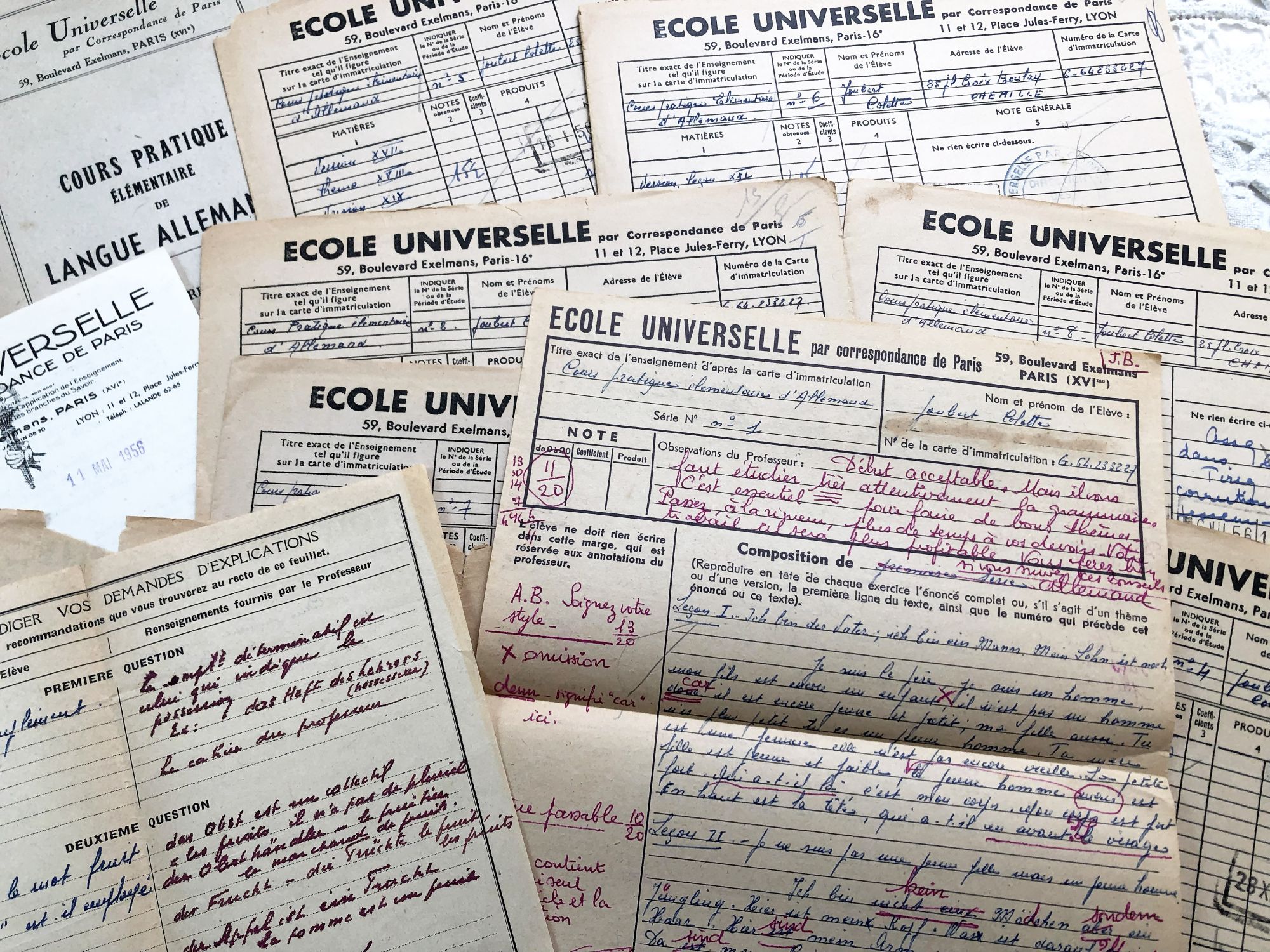
Photo by the relatively famous New York photographer...
Photo by the relatively famous New York photographer James Alba Bostwick Expired from the end 19th.







7 French - German correspondence school works with a letter and a small booklet from 1950s
Except for digital products, all items are not reproductions, so there may be some wear and tear depending on age what makes it so charming.
Feel free to contact me if you have any questions.
The dimensions and weight of the items offered on this site are expressed in centimeters (cm) and in kilogram (kg).
Here is some information to help you convert them into your own measurement system:
- 10 cm is about 4 inches,
- 1 kg is about 2.2 pounds.
Photo by the relatively famous New York photographer James Alba Bostwick Expired from the end 19th.
French engraving representing a buffalo and a bison by the drawer Victor Adam dating from the middle of the 19th century.
Jean-Victor Vincent Adam, born in Paris on January 28, 1801 and died in Viroflay on December 30, 1866, is a French painter and lithographer. He has illustrated numerous works and his drawings have been interpreted in engraving by Antoine François Gelée, Émile Giroux and Jean-François Pourvoyeur.
This engraving is probably the result of a reissue of the encyclopedia on wildlife of Buffon.
Vintage French postcard with a bouquet of roses from 1930s.
Old French photograph of a woman of the middle class made by the photographer Léon Langlois in Paris. This photograph can be dated from 1882 to 1890 since Léon Langlois began his activity in 1882 at 7 Boulevard Sébastopol and moved his photography salon in 1890 at 76 Boulevard Voltaire.
Set of 10 photos of the city of Delft (Netherlands) in the 1950s.
These photos are typical of the 1950s and 1960s, during which tourism progressed a lot but not all tourists were equipped with a camera. These photos were sold on the tourist sites allowing everyone to keep a souvenir of the visit.
French religious card - First communion card from 1910s
Large 24-page French weekly newspaper "Le Gaulois du Dimanche" of September 1909 with beautiful Art Nouveau cover, many articles about history, fashion, arts, literature, music, kitchen, and many engravings and photos.
Le Gaulois is a daily French literary and political newspaper founded on July 5, 1868. It became the property of press boss Arthur Meyer and was published until 1929 before being merged with the Figaro. Due to it large size, this magazine will be sent folded in half.
Large 24-page French weekly newspaper "Le Gaulois du Dimanche" of August 1909 with beautiful Art Nouveau cover, many articles about history, fashion, arts, literature, music, kitchen, and many engravings and photos.
Le Gaulois is a daily French literary and political newspaper founded on July 5, 1868. It became the property of press boss Arthur Meyer and was published until 1929 before being merged with the Figaro. Due to it large size, this magazine will be sent folded in half. A page is slightly torn as shown in one of the photos.
French engraving representing of a lioness and a cougar by the drawer Edouard Travies dating from the middle of the 19th century.
Édouard Traviès de Villers, born in Doullens on March 24, 1809, and died in Paris 5th on November 18, 18761, is a well-known animal painter, illustrator and lithographer. This engraving is probably the result of a reissue of the encyclopedia on wildlife of Buffon.
Large 24-page French weekly newspaper "Le Gaulois du Dimanche" of October 1909 with beautiful Art Nouveau cover, many articles about history, fashion, arts, literature, music, kitchen, and many engravings and photos.
Le Gaulois is a daily French literary and political newspaper founded on July 5, 1868. It became the property of press boss Arthur Meyer and was published until 1929 before being merged with the Figaro. Due to it large size, this magazine will be sent folded in half.
Set of 10 photos of the city of Tulle (France) in the 1950s.
These photos are typical of the 1950s and 1960s, during which tourism progressed a lot but not all tourists were equipped with a camera. These photos were sold on the tourist sites allowing everyone to keep a souvenir of the visit.
French postcard representing a young woman in front of an easel with the inscription "Bonne fête" from 1910s. This postcard dates from 1910s.
In Europe and probably in other countries, it is tradition to wish a "bonne fête" to relatives and friends according to their first name and the calendar of saints. It is a tradition dating from the 16th century that lasted until the beginning of the 20th century and is gradually being lost.
Vintage Belgian postcard representing a young girl and her mother teaching her to knit sent in 1913. Back probably written in Dutch.
Postcard legend: "Knitting lesson"
Huge French lottery tickets "Les gueules cassées" from 1940 and 1941.
These lottery tickets were sold on the street or in small shops to help veterans.
French postcard representing a young woman on a bicycle. This postcard dates from 1900s. It has been sent, but the back contains only the address.
This postcard was edited by the Parisian Etoile company created by the photographer and industrialist Gaston Piprot, inventor of the patented process "émaillographie". This process gave an incomparable quality of photography for the time as well as a new glazed aspect in the field of the postcard.
Postcard legend: "Si vous m'aimez, venez prendre un baiser et ces fleurs" / "If you love me, come take a kiss and these flowers"

7 French - German correspondence school works with a letter and a small booklet from 1950s
